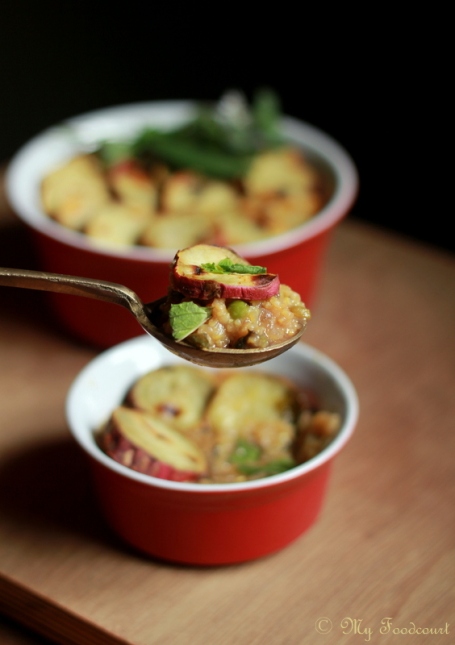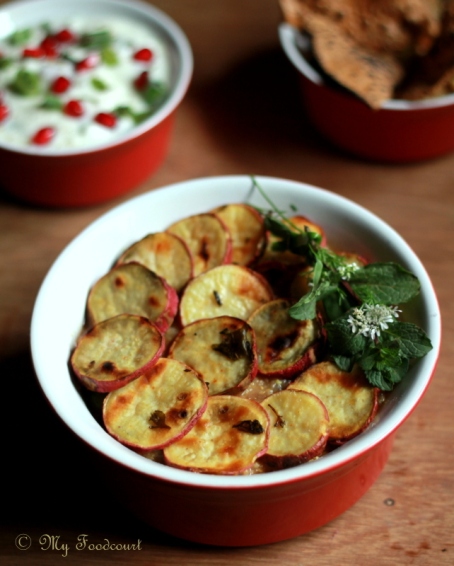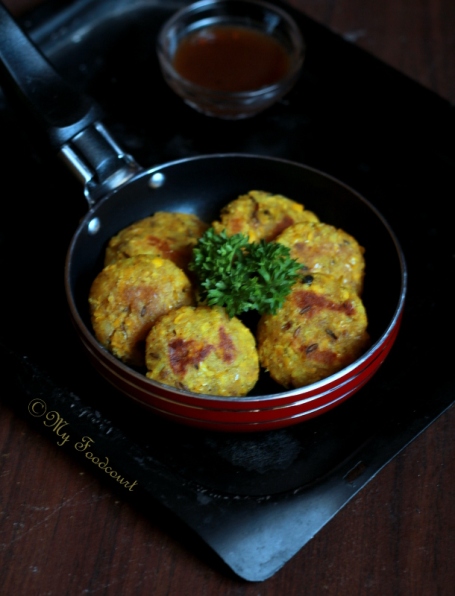Posts filed under ‘turmeric’
Back to School with Egg Bhurji Stuffed Pita Pockets
Egg Bhurji stuffed Pita pockets is a great for the kids lunch box or for a lazy weekend brunch or very handy as a meal/snack ‘on-the-go’. You can even involve the kids to make their own lunch/snack.
India’s Best blogger, Khadya Jatra and Khandeshi Cuisine
India’s Best blogger, Khadya Jatra and Khandeshi Cuisine….confused? …read on 🙂
2016 seems to have started on a very positive note! Betterbutter had organized ‘ India’s top blogger contest ‘.To participate we had to Curate a meal for two in a foodbook to make a complete meal. I participated and my foodbook menu included- Meetha Pan spritzer, Mini Thalipeeth Tostadas, Garam Masala spiced Palak Paneer Timbale and Meringue nests topped with Mango curd and fruits. 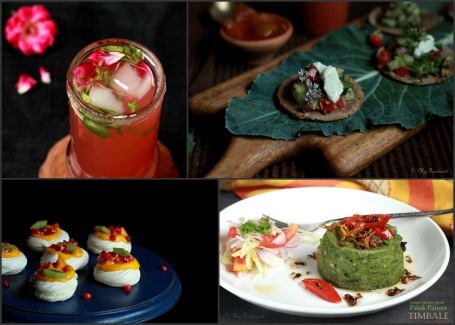
As you must have guessed by now, I won the India’s top blogger contest! The prize is as awesome as the concept & contest- a gorgeous orange coloured Le Creuset Casserole! Thank you again Betterbutter for this!
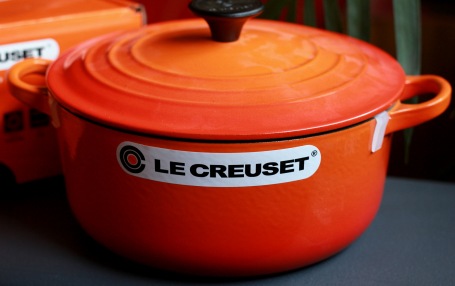
The recipes are already on the blog or you can check out the foodbook and some of my recipes here on betterbutter.
Khadya Jatra: I wrote this article for a Facebook group initiated by Saee of My Jhola– Angat Pangat, which re-discovers traditional Maharashtrian cuisine. We are starting with a new series on the group called ‘Khadya Jatra’ #APKhafyaJatra ,where a specialist of a particular sub-cuisine of Maharashtra will curate some background information about it and give an authentic recipe with step by step images.Members can then try out the recipe and thus get a chance to learn about the sub-cuisine and recipes.
I am fortunate to be the first ‘specialist’ and Saee invited me to curate some information and a recipe about Khandeshi Cuisine.Thank you Saee for this,I am honoured.
Spicy, fiery gravies with a thick sinful layer of oil floating on top (tarri) -that’s a trademark Khandeshi dish for you!
Nashik (where I stay) borders the Khandesh region (some parts of present Nashik district are part of Khandesh),has a strong influence of the Khandesi cuisine and you can see specialties like Misal and Shev Bhaji dished out at every nook and corner.
The quintessential Kala Masala forms the base of most gravies (rassa) along with dry coconut (khobra), onion and garlic. These are traditionally served with Bhakri or Rice.

Peanuts and peanut oil is also extensively used for cooking. Peanuts, small green lavangi mirchi or fiery Red mirchi, garlic are roasted on an iron griddle or directly on charcoal, pounded in a wooden mortar and pestle (Badgi-musal) to make the famed Thecha. Apart from the staple Jowar Bhakri, Kalnyachi Bhakri- Chutney is very popular with most Khandeshi’s. Kalna is a blend of Jowar + Urad and is served with a spicy peanut chutney.
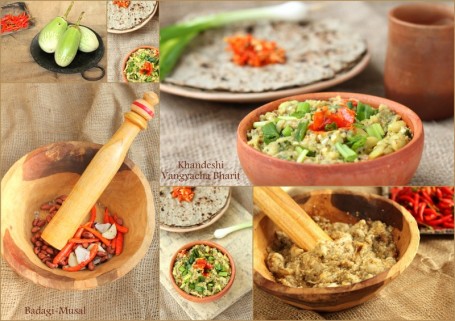
The Khandeshi love for eggplants need not be stressed. Be it Bharit made using large green eggplants (Jalgaoni Vangi) or small eggplants stuffed with kala masala or mashed eggplants (Ghotleli Bhaji), every Khandeshi loves this vegetable! The Ghotleli Bhaji and Dal batti are part of many festivities in most Khandeshi households.
Mande (Khandeshi version of Puran Poli) and Wheat Kheer are the popular sweets from the region.
The hot summers are utilized to make different types of Papads and Vade (Valvan) like the laborious yet rewarding Bibde.
A very popular Khandeshi preparation is Patodyachi (or Patvadya) Bhaji. Rolled out Besan flour dough is cut into strips and cooked in a spicy kala masala gravy. The other lesser known form of this preparation is called ‘Dubuk Vade’. Instead of making strips, dumplings are made from the besan batter and cooked in a similar gravy. I am guessing the name Dubuk comes from the noise it makes when a dumpling is dropped in the gravy-I am not sure of this though 🙂

It is simple, it is spicy, it is fiery, it uses Kalal masala gravy and it is absolutely lip smacking- ticking all the right boxes for typical Khandeshi, homestyle food. I have toned down the heat and oil to suit our taste; you can adjust it to yours.
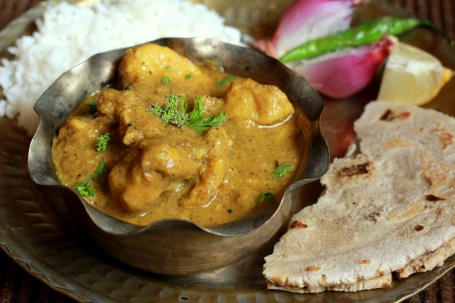
Here’s the recipe for Dubuk Vade
Recipe serves ~ 3-4 persons
Ingredients
For the Rassa
2 onions, sliced
¼ cup dry coconut, grated (Khobra)
4-5 garlic cloves
Handful of fresh coriander leaves, cleaned and washed
2 teaspoons Kala Masala (or to taste)
1 teaspoon Red chilli powder
½ teaspoon turmeric powder
2+2 tablespoon oil, divided (or more if you like)
2 teaspoon Cumene seeds (jeera)
Salt to taste
Water as required
For the vade (dumplings)
¾ cup Besan, sieved (gram flour)
2-3 garlic cloves, finely minced or grated
½- 1 teaspoon red chilli powder
½ teaspoon turmeric powder
¼ teaspoon asafoetida (hing)
Salt to taste
Method
To make the Rassa
Heat 2 tablespoon oil on an iron griddle or in an iron wok.
Add the onions and garlic and sauté till the onions start browning. Stir so that the onions and garlic are sautéed evenly.
Add the grated coconut and sauté till it just starts browning and starts emitting the aroma.
Add the coriander. Stir around to mix.
Take it off the heat and add the red chilli powder and kala masala.
Mix and cool completely.
Grind the masala, in a blender, using very little water to a smooth paste.
Heat the remaining oil in a saucepan/wok.
Add the cumin seeds.
Once they sizzle, add the ground masala and sauté.
Cook till the water evaporates and the oil starts oozing out, taking care not to burn the masala.
Add sufficient water (about 2 ½ -3 cups) to make a medium consistency gravy.
Season with salt and let the Rassa boil for a few minutes.
Meanwhile make the dumplings
Mix all the ingredients under dumplings. Add water to make a batter of dropping consistency (~ ½ cup)
Drop spoonfuls of the batter in the boiling Rassa, working quickly so that all the dumplings cook evenly. Add little water to the bowl/vessel in which you made the dumpling batter, whisk and add that to the gravy so that it will thicken a bit.
Cook for a few minutes till the dumplings are cooked through (about 8-10 minutes) and the gravy thickens a bit. (add water if it is too thick)
Serve hot with Jowar Bhakri or Rice, with a raw onion and lemon wedge on the side
Note: If you want that layer of oil floating on top, use more oil and chilli powder.
Rajasthani Papad Mangodi ki Kadhi for Regional Indian Home cooking
Happy New Year to all the readers of My Foodcourt!

After all the festive binge eating, it is time now to get back to simple hearty meals. My friend Garima has a recipe for a comforting Rajastahni Papad Mangodi ki Kadhi, perfect for the nippy weather.
I met Garima when she was staying in Nasik. I was thrilled to discover another food blogger from Nasik! But by the time we actually met, sadly it was time for her to move to Bombay. We met just for a couple of hours and we connected instantly. I felt like we have known each other forever! She has some fabulous Rajasthani recipes on her blog Café Garima and I have bookmarked many of them.
Here’s Garima with her authentic Rajasthani Papad Mangodi ki Kadhi for my series on Regional Indian Home cooking.
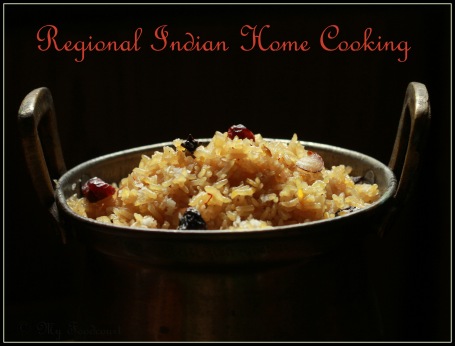
Hello! I am Garima and blog at Café Garima. I am delighted to be doing a regional guest post for Madhuli at her lovely blog ‘My Foodcourt’. A great admirer of Madhuli’s gorgeous pictures and unusual recipes, I am fortunate enough to have met her and cherish the beautiful couple of hours we spent together.
It is indeed, a pleasure to be here. Thanks for having me over Madhuli!
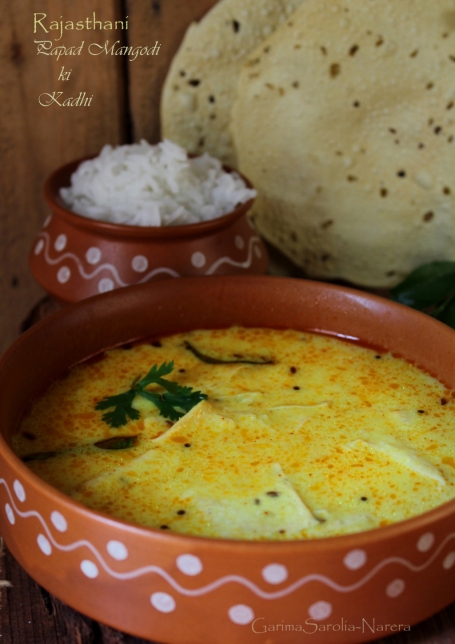
I present a traditional recipe from Rajasthan, Papad Mangodi ki Kadhi. I have fond childhood memories of Ma extracting butter from malai (cream) collected over a fortnight from atop the milk. Kadhi was then made from the buttermilk, which was left behind after having extracted the butter. It is a tradition I have carried on in my household.

Kadhi made from fresh buttermilk has a lovely earthy flavour. Moong dal nuggets or mangodis are added to the buttermilk curry as it cooks and roasted papads/poppadums are added at the end. A tempering of asafoetida and mustard seeds completes this very Rajasthani delight, very apt for a winter afternoon. Here is how I make it.
Papd Mangodi Kadhi Recipe
(Serves 4)
Ingredients
For the Kadhi
3 cups of buttermilk/ 1 cup of curd + 2 cups of water, beaten till smooth
2 Tbsp besan/gram flour
1 tsp salt
¼ tsp haldi/ turmeric powder
¼ cup mangodi
2-3 papads
For the tempering
1 Tbsp ghee
4-5 curry leaves
1 tsp rai/mustard seeds
¼ tsp jeera/cumin seeds
½ tsp red chilli powder
Method
Before you begin making the Kadhi, ensure that the buttermilk is at room temperature.
In a heavy bottomed vessel/kadhai add the salt and turmeric to the buttermilk and mix well, ensuring there are no lumps. Bring this mixture to a boil stirring continuously. Once the mixture has reached a rolling boil, reduce the heat and cook covered for 25 minutes. Keep adding water in case the mixture gets too thick. About 20 minutes into the cooking time, add the mangodi and half a cup of water. Cook till mangodi is done. Take off the flame. Break the roasted papads into large pieces and add to the kadhi.
To temper, heat ghee and add asafoetida, mustard seeds and cumin to it. Once the mustard begins to crackle, take off the heat and add curry leaves and red chilli powder. Spread over the Kadhi. Serve hot over rice or will chapatti.

Kid Friendly, Quick,Easy Snack- Corn & Sweet Potato Tikkis
My kids need to carry breakfast once a month to the school for their ‘Sharing Day’. Breakfast otherwise is provided by the school. Variety of Appe, sandwiches, pancakes have been the norm for the past months. This time the lad wanted something different. Since Sweet corn is a permanent resident in my refrigerator, we made these quick Corn & Sweet Potato Tikkis.
Our Dabbas got colorful this Holi! (That is as much as I celebrate the festival 🙂 ). These gorgeous beauties are from The Chalk Boutique. A colorful makeover of the traditional tiffin, these Dabbas are a welcome change from the Tupperwares and lock-n-locks (though they have their advantages :))
The Corn tikkis are quick and quite simple to make. Boiled corn, Sweet Potatoes, Breadcrumbs, cheese ,a few herbs /spices and you have a kid friendly snack ready in minutes.
Here’s the recipe:
Corn & Sweet Potato Tikki
Makes ~ 12-13 bite sized tikkis
Ingredients
3/4 cup Boiled Sweet Corn kernels,drained completely
2 slices Multigrain bread
2 small Sweet Potatoes boiled,peeled and mashed
½ tsp Ginger garlic paste
½ Onion finely chopped
2-3 Tbsp grated Cheddar Cheese
½ tsp Turmeric Powder
2 tsp dried or fresh Mixed herbs
2 Tbsp Corn Flour
Chilli flakes/Chilli powder/crushed black pepper to taste
Salt to Taste
~ 3-4 tbsp Oil for greasing the pan and to Saute the onions
Method
In the bowl of the food processor pulse together boiled corn and the bread slices to a coarse crumbly mixture.
Sauté the chopped onion in 1 tsp oil.
Add the ginger garlic paste and the turmeric powder.
Sauté for a minute more and cool.
Add the onions to the corn mixture and pulse once or twice .
Take this mixture in a mixing bowl. Add the mashed sweet potatoes, herbs, cheese, salt,Corn flour, chilli flakes/crushed Black pepper.
Mix together and form about 12-13 small balls of the mixture. Flatten these to make a small disk/tikki shape.
Grease a griddle pan with oil and grill the Corn Tikkis till lightly browned on both sides.
Serve hot with Tomato Ketchup, Imli Chutney or any chutney of your choice
(The lad took these to school and said they were just as good cold too)
Hadga/Agasti Flower Bhajias
A very Happy New Year to all of you.
I am back after a looooooong silence on MyFoodcourt. As you can guess the resolution for 2015 is to blog as much I can!
I have been thinking of posting recipes for a long time. The ‘comeback recipe’ for the blog has spanned from Christmas cake to Yule log to Pavlova to a humble porridge-but only in my mind!
A trip to the older part of the city a couple of days back lead me to a treasured discovery- the edible Hadga flowers. I had a faint memory of my childhood ,of my Mom using these flowers for cooking. The lady selling these flowers was kind enough to inform me that I need to remove the bitter tasting stamens from the flowers before cooking them.
A chat with Mom about these flowers and she was nostalgic about how these flowers reminded her of her childhood. (Now you know where my love for these offbeat, treasured foods comes from). Mom said she makes a ‘Pith Perun’ bhaji (stir fry with Besan/chana dal flour).Our house help informed me that you can make sinful Bhajias with these flowers. The dipping mercury made the Bhajias more tempting than the stir fry …and so Bhajias were made. The stir fry has to wait its turn, but I had to blog about these treasured flowers rightaway!
 FB comments on the photo of the flowers and Google research have enlightened me that they are also known as Agasti,Bokful in other Indian languages and also that they are eaten as a vegetable in Southeast Asian countries.
FB comments on the photo of the flowers and Google research have enlightened me that they are also known as Agasti,Bokful in other Indian languages and also that they are eaten as a vegetable in Southeast Asian countries.
I have used carbonated water just to make the Bhajias crispier- just plain water will be fine too.We enjoyed the crispy Hadga Bhajias sans accompaniment.
Here’s my recipe for
Hadga Flowers Bhajia
Ingredients
8-10 Hadga flowers (the younger flowers are better for Bhajias, but I had to make do with whatever I had)
½ cup Besan/Chana dal Flour
½ cup Rice flour
½ tsp Asafoetida(hing)
½ tsp turmeric powder
½ tsp Red chilli powder
½ tsp Ajawain/carom seeds (optional)
Carbonated (or plain) water to make a the batter
Salt to taste
Oil for deep frying
Method
Heat the oil in a wok.
Remove the stamens from the flowers and keep aside.
Mix the flours, spices, Ajwain and salt in a bowl.
Add 2 tsp of the hot oil to this dry mix.
Add the carbonated water to the dry mix to make the batter (not too thick, not too thin) ~ 1/4 cup
Coat each Hadga flower with the batter and deep fry on medium heat till crisp and lightly browned.
Serve immediately.
5 years of Blogging and My Mom’s Puran Poli with Katachi Amti
Puran Poli is a quintessential Maharashtrian delicacy and you may wonder how it has not featured on My foodcourt in the past 5 years. Yes, My Foodcourt turned 5 this August! I have been neck deep in work, kids and the daily grind. August and now September just zoomed past me and I just realized that it’s been fabulous 5 years of blogging; sharing and interacting with my virtual friends! Its late but we are celebrating nevertheless 🙂
Many festivals in Maharashtra like Holi, Gudi Padwa, Gauri-Ganapati Puja,Dassera feature the Puran Poli as its star attraction, as far as the festival food is concerned. The skills of a good Marathi cook are gauged by the way he/she can make the Puran Poli. My dad is a very good cook and to explain effectively his cooking skills I just say that he can make good Puran Poli’s and Bhakris! I don’t have to say anything else, it’s understood that he is indeed a very good cook 🙂
Regular readers of this blog know that I don’t have a weakness for sweets, in fact far from that and maybe that’s the reason why Puran Poli has not been featured on My Foodcourt. My mom makes one of the best Puran Polis and even I cannot resist eating her Puran Poli. She uses some fresh coconut and Khoya/Khawa/Mawa in addition to the usual Chana dal for the filling to enhance the richness and flavor. The proportion of jaggery and sugar is just apt for my taste buds.
I got a chance to capture the Puran Poli making process this time when I stayed over at my parents place during the Gauri- Ganapati festival. The consistency of the Puran/stuffing, the dough and the skill of rolling them out determine the resultant nature of the Puran Poli. With a little bit of practice you can make decent Puran Polis. The amount of effort put into making Puran Poli is worth every bit.
My Mom made it for many people (~40 Puran Polis) and hence the proportions appear in kg. You can scale it to your requirement. She made the Puran a day in advance, so she didn’t have too much work the next day. Also the left over Puran can be stored in the freezer in a sealed bag/container and used as and when required.
The Puran Poli is usually served with Katachi Amti , made from the leftover stock from cooking the Chana Dal. The stock is spiced up with different masalas to balance the sweetness of the Puran Poli.
Note: This is an indulgent sweet and needs all the oil, ghee, sweetness and richness that is mentioned below. So make this when you are not too conscious of the calories being consumed 🙂
Here’s celebrating 5 years of My Foodcourt with my Mom’s Puran Poli recipe:
My Mom’s Puran Poli recipe
For the Puran (Stuffing)
1 kg Chana Dal
½ tsp Turmeric
¾ kg Jaggery
3/4th Katori Sugar (my mom uses a katori/Vati to measure for her measurements)
200 gms Khoya/ Khawa/Mawa ( you can use Pedhas)
½ medium sized freshly grated coconut
Nutmeg powder ½ tsp (optional)
For the covering Dough:
½ kg Wheat Flour
1 tbsp All purpose flour
Pinch of salt
Oil as required
Rice Flour for dusting the Puran Poli
Method:
For the Puran (Stuffing)
Cook Chana Dal with twice amount of water, with turmeric in a pressure cooker till very soft but not mashed. (about 2 whistles and ~15 mins on low flame thereafter.)
Meanwhile roast the Khoya in a pan on low heat till slightly pink/very light brown.
Grind the Coconut in the mixer to a fine paste without adding water.
Drain and remove water from the cooked Dal and reserve the water.
Heat a kadhai and add the dal and on a low flame dry out all the moisture from the Dal.
Add the jaggery, sugar, coconut paste, roasted Khoya to the dal.
Cook and stir till the mixture is completely dry. (take care not to burn the mixture)
Add the nutmeg powder mix well.
Remove the mixture from the heat and pass it through a Puran press/ Food Mill.
Keep aside till you are ready with the covering dough. This filling can be made 1-2 days in advance and stored in an airtight container in the refrigerator.
For the Covering Dough:
Sift the wheat flour and the all purpose flour and pinch of salt through a fine mesh sieve.
Add oil (2-3 tbsp) and water and knead into a soft elastic dough. (You may need to add more water/ oil to get very soft dough)
Keep the dough covered for about an hour.
After an hour add about 3/4th Katori oil, salt and little water to make it more soft.
Take a lemon sized ball of the dough. Flatten it using the finger tips with the help of the Rice flour
Take a bigger ball of the Puran/stuffing mixture.
Place it on the flattened dough,seal and cover it with the dough such that the Puran gets stuffed inside the dough.
Roll out the stuffed dough using the Rice flour for dusting into a round chapatti (as thin as possible), taking care that the Puran/stuffing does not come out and the chapatti does not stick to the surface.
Heat a non-stick tava/griddle.
Once rolled out, use the rolling pin to transfer the Puran poli to the tava.
Cook on both sides till golden brown.
Remove from the tava.
Serve hot Puran Poli’s with a generous drizzle of hot melted ghee and Katachi Amti (recipe below).
Katachi Amti Recipe:
Stock/water left over from cooking the Chana dal for Puran (above) add water if required to make it thinner.
3-4 cloves
4-5 Black pepper corns
1-2 tsp Mustard seeds
1-2 tsp cumene seeds
7-8 curry leaves torn into pieces with hand
1 tsp grated jaggery
1 tsp tamarind pulp
1 tsp Maharshtrian Kala Masala or Garam Masala
~4-5 tbsp chopped fresh Coriander leaves
Salt to taste
2 tbsp oil
Method:
Heat the oil in a deep pan.
Add the mustard seeds.
Once they splutter, add the cloves and peppercorns fry 1-2 second and then add the cumene seeds.
Add the curry leaves and the coriander leaves.
Add the Kat/stock .
Add the jaggery, tamarind pulp, Masala and season with salt. (you can adjust the proportion of jaggery and tamarind to your taste.)
Bring it to a boil and serve hot with Puran Poli.
Stay Tuned for a fabulous Giveaway coming soon on MyFoodcourt!
Pepper away the Monsoon blues with this quick and simple Black pepper Rasam/soup
The medicinal uses of Black pepper are well known. It is one of the trusted home remedies for cold and cough. We have been surviving the Monsoon bug by adding this ‘natural antibiotic‘ to our day-to -day meals.
We are having this hot spicy Pepper Rasam/ soup almost every day to soothe our itchy throats; a soothing balm to ‘shoo’ away the Monsoon blues.
This is of course my Mother-in-law’s recipe and uses very few day-to-day ingredients; Black pepper-cumene seeds –some dried coconut and curry leaves. You can make a ready spice mix and store in an airtight container. Whenever you want to make the rasam just boil some lentils add the ready spice mix and viola! your ‘magic potion’ is ready in minutes
Here’s the recipe for Pepper Rasam/Soup
Things required:
¼ cup Toovar Dal (pigeon pea lentils)
8-10 Black pepprcorns
~2 tsp Cumene seeds
~ 1 tbsp dried coconut grated
4-5 curry leaves
Pinch of turmeric and few drops of oil to cook the Lentils
Salt to taste
1 tsp homemade ghee
Method:
Pressure cook the dal with ~ 2 ½ cups of water, a pinch of turmeric and 3-4 drops of oil.
In a pan dry roast black peppercorns, cumene seeds, dried coconut and curry leaves one by one.
Cool and coarsely grind the spices in a mortar and pestle.
Heat ghee in a deep pan.
Add the spice mix.
Add the cooked dal along with the water. Adjust the consistency of water to your liking.
Season with salt and boil for few minutes.
Serve piping hot.
Notes:
You can adjust the spices to your taste, it is a very forgiving recipe.
You can skip the ghee if you don’t want it, just mix the spices and the dal and boil together.
If you plan to serve this as a clear soup, let the soup stand for a few minutes and then just pour out the liquid. You can use the leftover dal to make some dal parathas or sambar
You can zest up the soup with a dash of lime juice
Power Breakfast for these ‘under the weather’ days
The monsoon bug does not seem to leave our house; it’s been almost like a hospital for the past few days! The wet sultry days are no help for recovery. The coughing and sneezing seems to have affected the palate as well as the appetite. Quick, wholesome food is helping us sustain these depressing days.
Here’s a recipe for a quick and wholesome Cracked wheat (Dalia) Upma dressed up with corn, moong bean sprouts and a few spices. Corn was added for the little ‘corn fan’ in the house. To pep up our appetites I added some kasuri Methi and a hint of Pav Bhaji masala to the cracked wheat, and that’s what is did-jazzed up our meal!
Here’s the recipe:
2 cups Cracked wheat, washed and pressure cooked (with salt and 3 ½ cups water)
1 cup Sweet corn
1 cup moog bean sprouts
1 small onion chopped
~ 2-3 tsp kasuri methi
½ tsp Pav Bhaji Masala (I used Everest)
3-4 dry red chillies broken into pieces
~2 tsp roasted peanut powder
½ tsp ginger-garlic paste
½ tsp turmeric powder
½ tsp cumene seeds
½ tsp mustard seeds
Salt to taste
~2-3 tsp oil
Lemon juice, coriander/mint leaves for garnish
Heat oil in a pan. Add the tadka ingredient; mustards seeds-cumene seeds-turmeric- redchillies.
Add the onion and ginger garlic paste and sauté for 1-2 minutes.
Add the corn and moong beans.
Add salt and mix nicely (the cooked Cracked wheat also contains salt.)
Cook covered for ~5-6 minutes. (Don’t overcook, the corn and moong sprouts should be crunchy)
Add the Pav Bahji masala.
Crush and sprinkle the Kasuri Methi.
Add the cooked Cracked wheat and peanut powder, mix well.
Cook covered for 1-2 minutes more.
Garnish with Lime juice/coriander/mint leaves and serve hot.
Note: You can use any fresh vegetables of your choice along with the corn and Moong sprouts.
Comfort food-Poha(beaten rice) spiced with Methkut
I was feeling a bit under the weather for the past few days. The wet rainy days did not help to lift up my spirits. Elaborate cooking took a back seat and it was time for some quick easy meals.
Poha (beaten rice) is a must-have ingredient for all Maharashtrian pantries. It is a regular item on the ‘essential items’ in the monthly grocery list. Poha is a handy ingredient when you have unexpected guest, you are pressed for time, need a quick meal or when you want some comfort food!
The modest Poha is dressed up here with a few spices and a classic Methkut powder to make one of the most delightful comfort foods for me.
The recipe is quite forgiving and does not need any pre-planning. Day-to-day ingredients are used and it can be made at the last minute.
The key ingredient used to flavor this Spicy Poha is a Methkut. Methkut is a classic powder made from a few dals and spices and is used in most Maharashtrian households to flavour soft cooked rice; again a comfort food and one with lot of childhood memories.
I used readymade Methkut powder but you can find recipes here and here.
This spiced Poha makes a great tea time snack along with a cup of spiced Chai or a glass of freshly brewed filter coffee.
Here’s the recipe:
2 cups Thin poha (beaten rice)
2-3 tbsp Methkut powder
3-4 tsp coconut water /buttermilk/milk or just plain water
Pinch of sugar
Salt to taste
For the tadka (tempering):
A handful of peanuts
A handful of roasted Chana dal (Dalia)
4-5 dry Red chillies cut into pieces
4-5 curry leaves torn into pieces
1 tsp mustard seeds
1 tsp cumene seeds
½ tsp turmeric powder
~2-3 tbsp oil
For the garnish:
Lime Juice
Fresh coriander leaves
Method:
Sprinkle coconut water/buttermilk/milk or just plain water on the poha and mix to make it a little moist.
Add the methkut, salt and sugar and mix nicely to coat the poha. (Adjust the amount of Methkut to your taste).Keep it aside.
Heat oil in a small pan.
Add the mustard seeds and once they splutter add the cumene seeds followed by the peanuts.
Fry the peanuts well and then add the roasted chana dal.
Add in the turmeric powder, Red chilles and curry leaves.
Add this tadka\tempering to the poha and mix nicely.
Keep covered for a ~ 5 minutes for all the flavours to mingle.
Garnish with lime juice and coriander leaves.
Variation: If you cannot find Methkut you can use the Chutney podi which is normally served with dosa.
Or I have blogged about another version of spicy Poha (Dadpe Pohe) earlier on My Foodcourt here.
Also see Poha spiced with Tamarind


